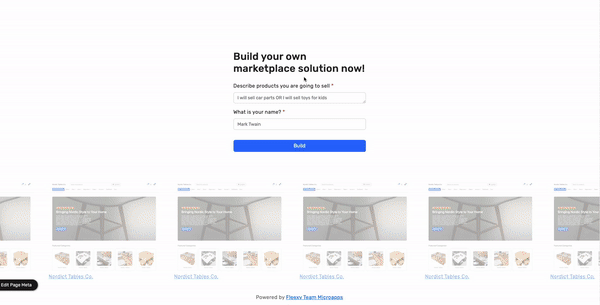Subscription models
The subscription-based business model has taken the e-commerce world by storm, experiencing tremendous growth over the past few years. With an annual growth rate of over 100% in the subscription e-commerce market it's clear that subscriptions are here to stay.
What's behind this surge in popularity? Well, it's all about convenience and personalization. Subscriptions offer customers the ultimate convenience of regularly delivered products, eliminating the need for constant reordering. Plus, the personal touch of tailored offerings keeps customers engaged and coming back for more.
But it's not just customers who benefit. Brands are embracing subscriptions as a way to ensure a consistent revenue stream and foster long-term loyalty. In an ever-evolving e-commerce landscape, subscription-based businesses are becoming a go-to option for both retailers and consumers.
To attract and retain loyal customers, brands are getting creative with their subscription models. Many B2C companies are marketing subscriptions as money-saving opportunities, even offering lifetime price rates as incentives. Exclusive gated membership communities like Fabletics and Lululemon are also on the rise, tempting customers with VIP treatment and access to exclusive products and events.
The appeal of these benefits is so strong that Lululemon, for example, expects a whopping 80% of their customers to sign up for membership within the next five years. They're not just promoting their subscription and community; they're actively engaging with customers on social media, surprising and delighting them with subscription offers.
In a world of economic uncertainty and rising prices, subscription models are proving to be a win-win for both businesses and customers. So, whether it's for the convenience, the savings, or the VIP treatment, subscriptions are changing the way we shop and fostering a loyal customer base in the process.

Social Commerce
Social media platforms like Facebook, Instagram, and Pinterest are no longer just spaces for connecting and sharing; they have evolved into bustling e-commerce hubs. With the introduction of shopping features like Instagram's Checkout and Facebook's Marketplace, these platforms are transforming the way we shop online.
Gone are the days of jumping from one website to another to make a purchase. Social media has bridged the gap, offering a seamless shopping experience within the platforms themselves. Imagine scrolling through your Instagram feed, stumbling upon a trendy outfit, and with just a few taps, you can buy it right then and there, without ever leaving the app.
This integration of shopping features is revolutionizing the world of e-commerce and is set to drive the growth of social commerce in 2023 and beyond. The convenience and simplicity of making purchases directly on social media platforms have captured the attention of users and businesses alike.
Instagram's Checkout feature, for instance, allows users to explore products, view detailed descriptions, and make secure purchases without being redirected to an external website. Facebook's Marketplace provides a space for users to discover, buy, and sell a wide range of products within their social network.
The impact of social commerce is significant. Businesses now have access to a vast pool of potential customers, tapping into the immense user base of these platforms. On the other hand, users benefit from a more streamlined and integrated shopping experience, discovering new products and making purchases with ease.
As social media platforms continue to evolve, we can expect even more innovative shopping features and collaborations with brands. Social commerce is blurring the lines between socializing and shopping, creating a new era of convenience and accessibility in the e-commerce landscape.
So, the next time you're scrolling through your favorite social media platform, keep an eye out for those enticing shopping tags and buttons. You never know when you might stumble upon your next must-have item, just a few clicks away.

Personalization
In the ever-evolving world of e-commerce, personalization is the name of the game. Consumers crave unique and tailored shopping experiences, and retailers are rising to the challenge by harnessing the power of data analytics and artificial intelligence (AI).
Data is at the heart of this revolution. E-commerce retailers are collecting and analyzing vast amounts of customer data to gain insights into their preferences, behaviors, and purchase patterns. This valuable information serves as the foundation for creating personalized shopping experiences that resonate with individual customers.
With the help of AI, retailers can leverage this data to deliver customized product recommendations, targeted advertisements, and personalized email marketing campaigns. It's like having a virtual shopping assistant who knows exactly what you need and when you need it.
Imagine browsing an online store, and suddenly, you're presented with a selection of products that align perfectly with your style and preferences. Or receiving an email showcasing exclusive offers on items you've been eyeing for a while. These personalized touches make the shopping experience feel tailor-made just for you.
In 2023, this trend is set to reach new heights. Retailers will continue to refine their personalization strategies, combining customer data with predictive analytics to anticipate customer needs and desires. By analyzing past behaviors and trends, retailers can proactively offer products and recommendations that align with customers' tastes, even before they realize they want them.
The benefits of personalized shopping experiences are twofold. Customers feel seen and understood, fostering a sense of loyalty and connection to the brand. Retailers, in turn, benefit from increased customer satisfaction, higher engagement, and ultimately, greater conversions and sales.
So, the next time you embark on your online shopping journey, keep an eye out for those personalized recommendations and tailored experiences. Behind the scenes, data analytics and AI are working tirelessly to curate a shopping experience that feels uniquely yours. Get ready to be wowed by the power of personalization in the world of e-commerce.

AI in Personalized Shopping Experiences
AI's rapid growth is revolutionizing custom shopping experiences by gathering valuable customer data, such as shopping habits, preferences, and timing of purchases. This information empowers brands to deliver personalized shopping experiences tailored to individual customers.
Imagine having your favorite sales associate with a technological twist. AI can recommend new shoes you might like or share details about upcoming sales, enhancing your shopping experience.
Although we're not yet at the stage where AI robots can express human emotions as depicted in science fiction, practical applications of AI in customer service are emerging. Companies are leveraging AI to compose responses for customer care interactions, such as checking the status of an item. Embracing AI will enhance efficiency as customer journeys become increasingly complex.
As AI bots continue to improve their communication skills, brands can train them to offer more advanced customer service, including product recommendations based on customers' moods and preferences.
But there are not only bots powered by AI. Nowadays, as technologies are moving really fast, you can meet AI-powered landing page builders like Unicornplatform. Or the whole e-commere website builder like Fleexy’s Marketsy. The fully working solutions are generated by AI using a simple prompt. So you can not only improve but also start a new e-commerce business or marketplace using AI.

The Power of AR and VR in E-commerce
AR and VR technologies are revolutionizing the world of e-commerce by providing immersive and interactive experiences for customers. These technologies enable customers to visualize products in ways previously unimaginable.
By embracing AR and VR, retailers can offer engaging shopping experiences that foster brand loyalty and drive higher sales. The VR retail solutions market is projected to reach $5.5 billion by 2028, while the AR retail market is expected to reach $6.7 billion.
With augmented reality (AR) commerce, customers can "try before they buy" using 3D mapping technology. This has transformed industries like fashion, beauty, and home decor, as customers can virtually experience products and services at their fingertips. Brands can leverage AR commerce without physical stores, expanding their reach.
Benefits of AR commerce include:
- Allowing customers to experience products remotely
- Serving customers who lack nearby store access
- Enabling informed purchase decisions and reducing returns
- Providing cost-effective marketing and sales channels
Examples of AR commerce include virtual glasses try-on, furniture placement visualization, and makeup product testing.
Target, for instance, enhances the customer shopping experience through AR in its iOS app. Customers can superimpose common furniture items into their spaces to visualize their appearance, increasing confidence in purchasing decisions and reducing returns.

The summary
- Subscription Models: Subscription-based businesses have witnessed remarkable growth, offering convenience and personalization to customers while ensuring consistent revenue and fostering loyalty.
- Social Commerce: Social media platforms have transformed into e-commerce hubs, allowing users to make purchases without leaving the platform, driving growth and convenience in online shopping.
- Personalization: E-commerce retailers are utilizing data analytics and AI to deliver tailored shopping experiences through personalized product recommendations, targeted advertising, and customized email marketing campaigns.
- AI in Personalized Shopping Experiences: AI is revolutionizing custom shopping experiences by collecting and utilizing valuable customer data, enhancing efficiency, and improving customer service interactions.
- The Power of AR and VR in E-commerce: AR and VR technologies offer immersive and interactive experiences, allowing customers to visualize products and enabling retailers to provide engaging shopping experiences that drive sales and brand loyalty.
![Thumbnail for: PCI DSS Compliance Checklist: 12 Steps [2024]](https://mars-images.imgix.net/seobot/fleexy.dev/664bebf8f6ecb93f8e851d63-419bd59233a358fdf453f8afaa8eed7b.png?auto=compress)

